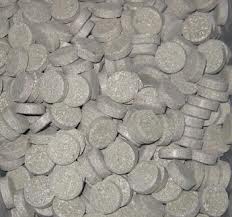Phosphine
| Infobox on Phosphine | |
|---|---|
| Example of Phosphine |  |
| Facts | |
| Origin | - |
| Stowage factor (in m3/t) | - |
| Humidity / moisture | - |
| Ventilation | - |
| Risk factors | See text |
Phosphine
Description / Application
Phosphine is the compound with the chemical formula PH3. It is a colourless, flammable, toxic gas. Pure phosphine is odourless, but technical grade samples have a highly unpleasant odour like garlic or rotting fish, due to the presence of substituted phosphine and diphosphane (P2H4). With traces of P2H4 present, PH3 is spontaneously flammable in air, burning with a luminous flame. Phosphines are also a group of organophosphorus compounds with the formula R3P (R = organic derivative). Organophosphines are important in catalysts where they complex to various metal ions; complexes derived from a chiral phosphine can catalyze reactions to give chiral, enantioenriched products. Phosphine is soluble in alcohol, ether, and cuprous chloride solution; slightly soluble in cold water; insoluble in hot water.
Phosphine is used as a pesticide.
Phophine gas has long been recognized as highly toxic. However, it is not widely known that it is, potentially, an inflammable gas, with a low flammability level of 1,8% by volume in air. In the event that a mixture of air/phosphine – in which the phosphine concentration exceeds its inflammable limit – is ignited in a confined space, it is highly probable that an explosion will occur.
Phosphine gas is generated from aluminium phosphide tablets by reaction of the aluminium phosphide with moisture in the air. This process, in addition to liberating phosphine, also produces aluminium oxide as a by-product. Additionally, small quantities of another gas known as diphosphine are also sometimes produced during this reaction. Unlike phosphine, diphosphine is spontaneously inflammable, reacting instantly with oxygen in the air. Production of diphosphine occurs in a similar way to that generating phosphine, i.e. by reaction between aluminium phosphide and moisture, but in this case the aluminium phosphide tablets contain an imbalance between the aluminium and phosphorous, with an excess of phosphorous compared to aluminium. Such a situation may arise during production of the tablets if an excess of phosphorous is inadvertently used during preparation.
Although not proven definitely, it is likely that potentially explosive mixtures of air and phosphine are frequently encountered during the first 12 to 24 hours of phosphine fumigations when the phosphine concentration in the upper reaches of the hold reaches a peak concentration. The resulting high concentrations of phosphine then disperse by diffusion, with the gas diffusing into the less accessible portions of the cargo.
Aluminium phosphide tablets are routinely used in fumigation and a very large number of shipments are fumigated annually without problems. Incidences of explosions are therefore very rare and as far as known, fumigant explosions have only been encountered when companies have used cheaper brand of aluminium phosphide tablets produced in developing countries. Such tablets could be envisaged as producing localised high concentrations of diphosphine leading to a very rapid reaction with oxygen and to ignition.
Shipment / Storage
The most widely used fumigant for intransit fumigation is phosphine (PH3). The gas is normally generated from aluminium phosphide or sometimes magnesium phosphide, but can also be applied direct from cylinders. Phosphine is only fully effective if a lethal concentration is maintained for a period of time that can be as little as 3 days or as much as 3 weeks. The actual time needed will vary according to the cargo temperatures, insect species that may be present, and the system of fumigation.
This is the reason why fumigation with phosphine is almost always carried out during the voyage (intransit) so that the voyage time can be used to ensure a fully effective treatment.
Phosphine gas is more dense than air and hence may collect in low-lying areas. It can form explosive mixtures with air and also self-ignite. When phosphine burns it produces a dense white cloud of phosphorus pentoxide – a severe respiratory irritant.
Phosphine can be absorbed into the body by inhalation. Direct contact with phosphine liquid – although unlikely to occur – may cause frostbite, like other cryogenic liquids. The main target organ of phosphine gas is the respiratory tract. According to the 2009 U.S. National Institute for Occupational Safety and Health (NIOSH) pocket guide, and U.S. Occupational Safety and Health Administration regulation the 8 hour average respiratory exposure should not exceed 0.3 ppm. NIOSH recommends that the short term respiratory exposure to phosphine gas should not exceed 1 ppm. The Immediately Dangerous to Life or Health level is 50 ppm. Overexposure to phosphine gas causes nausea, vomiting, abdominal pain, diarrhea; thirst; chest tightness, dyspnea (breathing difficulty); muscle pain, chills; stupor or syncope; pulmonary edema. Phosphine has been reported to have the odour of decaying fish or garlic at concentrations below 0.3 ppm. The smell is normally restricted to laboratory areas or phosphine processing since the smell comes from the way the phosphine is extracted from the environment. However, it may occur elsewhere, such as in industrial waste landfills. Exposure to higher concentrations may cause olfactory fatigue.
Note:
For overseas carriage aspects of Chemicals, the readers are recommended to acquire or have access to a good chemical dictionary, and a copy of the International Maritime Dangerous Goods (IMDG) Code, issued by the International Maritime Organisation. Also consult the applicable MSDS sheet.











